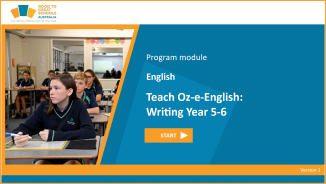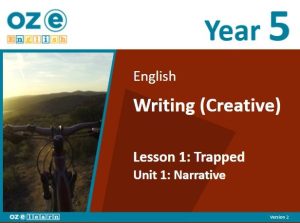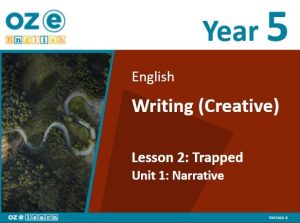Oz-e-English Writing (Creative)
Unit 1: Narrative
The Writing (Creative) units align to the Australian Curriculum Content Descriptions for Language and Literacy
Free Starter Lessons
Year Overview
Year 5
Australian Curriculum Content Descriptions
Overview
Unit 1: Narrative – Year 5 is an English language strand unit for Year 5 students. It aligns to the Australia Curriculum English Year Level Achievement Standards:
- Describe how spoken, written and multimodal texts use language features that are typically organised into characteristic stages and phases, depending on purposes in texts. (AC9E5LA03)
- Understand how noun groups can be expanded in a variety of ways to provide a fuller description of a person, place, thing or idea. (AC9E5LA06)
- Present an opinion on a literary text using specific terms about literary devices, text structures and language features, and reflect on the viewpoints of others. (AC9E5LE02)
- Recognise that the point of view in a literary text influences how readers interpret and respond to events and characters. (AC9E5LE03)
- Create and edit literary texts, experimenting with figurative language, storylines, characters and settings from texts students have experienced. (AC9E5LE05)
- Use interaction skills and awareness of formality when paraphrasing, questioning, clarifying and interrogating ideas, developing and supporting arguments, and sharing and evaluating information, experiences and opinions. (AC9E6LY02)
- Plan, create, edit and publish written and multimodal texts whose purpose may be imaginative, informative and persuasive using paragraphs, a variety of complex sentences, expanded verb groups, tense, topic-specific and vivid vocabulary, punctuation, spelling and visual features. (AC9E6LY06)
Learning Objectives
In Lessons 1 to 45, students will:
- Use the stimulus text to investigate the structure of narrative texts.
- Write narrative texts.
- Examine the format of a narrative using examples from literature with the theme of action.
- Learn how to recognise the crucial components of a narrative and apply this understanding to their own narrative writings.
- Create new texts together and follow the example texts’ building instructions.
- Use a handheld camera as a metaphor to recognise the changing scenes that make up the narrative.
- Use the metaphor of a drone to recognise the changing scenes that comprise the narrative.
Success Criteria
- Determine the general framework and constituent parts of a narrative.
- Enhance the exemplar text using ARMS.
- Plan the aspects of an action narrative using the anchor chart.
- Create an action story using the anchor chart.
Assessment
Progress Test
Progress tests are conducted after Lesson 5. They allow teachers to monitor student understanding of the concepts taught over the past five lessons and identify where reteaching is needed.
The Teaching Guide contains the progress test script and there is a handout for students to write their answers on.
End-of-Unit Assessment
Progress tests are conducted after Lesson 5. They allow teachers to monitor student understanding of the concepts taught over the past five lessons and identify where reteaching is needed.
The Teaching Guide contains the progress test script and there is a handout for students to write their answers on.
Other Units
Lesson Design
Lesson Objective
Success Criteria
Activating Prior Knowledge
I Do
We Do
Apple Question
You Do
Revise
Professional Learning



